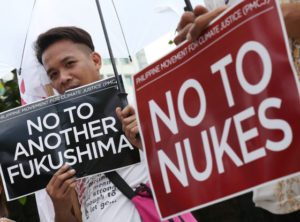The Department of Energy (DOE) is looking at the viability of nuclear energy as the Philippines intensifies its electrification program amid increasing population and strong economic growth.
DOE data showed that demand for electricity is expected to grow by an average of 5 percent per year until 2030, or around 126 terrawatthours (TWh) from the 2015 level of 82 TWh.
“To meet this requirement, we have to weigh all our options, with emphasis not just on meeting capacity requirements, but sustainability and environmental obligations as well,” Energy Secretary Alfonso Cusi said on Tuesday during the International Atomic Energy Agency (IAEA) Conference on the Prospects of Nuclear Power in the Asia-Pacific Region.
“Given its known characteristics, nuclear technology can be a viable choice for the country. We are told that on a [level] basis, nuclear power is an economical source, high on productivity and reliability, and low on costs and emissions. It is also said that the nuclear infrastructure and system is more cost-efficient in the long-term,” Cusi noted.
“Reports and special studies also say that operation of nuclear plants has become safer, more predictable and more dependable, with useful life of over 60 years,” he added.
With the new findings, technological advancements and successful experiences of countries around the world, nuclear energy holds promise for the national interest, especially in light of the country’s long-term energy plans, Cusi said.
The country’s power generation mix as of the end of 2015 is composed of 45 percent coal, 25 percent renewable, 23 percent natural gas and 7 percent oil.
The 2015 installed capacity mix is made up of 66 percent fossil fuels, 15 percent of which is in natural gas.
Cusi said the Philippines must have its own Energy Technology Roadmap to guide in the selection, adoption and innovation of technologies for its own use.
“This will require us to look at all current and emerging technologies and the many factors needed to make best use of them,” he added.
A total of 18 IAEA member-states are participating in the three-day conference: Bangladesh, Canada, Finland, Indonesia, Japan, Jordan, Kenya, South Korea, Malaysia, Mongolia, Saudi Arabia, South Africa, Sri Lanka, Thailand, the United Arab Emirates, the United States, Vietnam and the Philippines.



